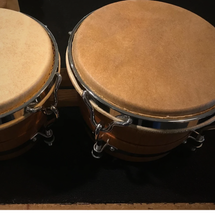Posted by Steve Head on 3rd Apr 2023
The Complete Guide On How to Tune a Set of Bongos
Bongos are a popular percussion instrument that originated in Cuba and are commonly used in Latin American music. These small, double-headed drums require tuning to achieve their signature sound, which is a high-pitched, crisp tone. Tuning bongos can be a bit challenging, especially for beginners, but with some guidance and practice, it can be done.
To tune your bongos, you will need a drum key, a small towel or cloth, and some patience. Before you begin, ensure that the bongo heads are in good condition. If they are worn or damaged, you will need to replace them before tuning.
Start by placing the bongos on a flat surface, with the larger drum on the left and the smaller one on the right. Use the drum key to loosen the lug bolts on the bongo heads. Lug bolts are the screws or nuts that hold the drum heads in place. Turn the lug bolts counterclockwise to loosen them, but be careful not to loosen them too much, as this can cause damage to the drum.
Next, use your fingers to press down on the center of each drum head. The center should be depressed, but not too much. If the center of the drumhead is too high or too low, it can affect the sound quality. Adjust the center by pressing down on it with the cloth or towel, using a circular motion. Press down on the center of the drumhead until it is level and has a slight depression.
Now, you can begin tightening the lug bolts. Start with the smaller drum, which is known as the macho. Tighten the bolts in a crisscross pattern, moving from one bolt to the one opposite it. This helps to distribute the tension evenly around the drum head. Tighten each bolt a little bit at a time, using the drum key. Remember not to overtighten the bolts, as this can damage the drum head.
After tightening the bolts on the macho, move on to the larger drum, known as the hembra. Tighten the bolts on this drum in the same way, using the crisscross pattern and tightening each bolt a little at a time.
Once you've tightened the lug bolts on both drums, it's time to check the sound. Tap the edge of each drumhead gently with your fingers, listening for the desired tone. Bongos should produce a high-pitched, crisp sound when properly tuned.
If the sound is too high-pitched, loosen the lug bolts slightly and tap the drum again until you achieve the desired tone. If the sound is too low-pitched, tighten the lug bolts a bit more and tap the drum again until the tone is correct. Make small adjustments and test the sound frequently, as even small changes in tension can have a significant impact on the sound quality.
Finally, when you are satisfied with the sound, mark the position of the lug bolts on the drumhead using a permanent marker. This will help you to remember where each bolt should be for future tuning sessions.
In conclusion, tuning bongos is a skill that takes time and practice to master. The key is to be patient and make small adjustments to the tension until the desired tone is achieved. Remember to tighten the lug bolts in a crisscross pattern, use a small towel or cloth to adjust the center of the drumhead, and mark the positions of the bolts for future reference. With practice, you will be able to tune your bongos quickly and easily, allowing you to focus on playing and enjoying the music.
As an Amazon Associate, I earn from qualifying purchases. This means that if you click on the link and make a purchase, I may receive a small commission at no extra cost to you. This helps support my work in providing quality content. Thank you for your support!
Check out my blog:


